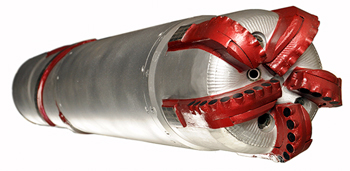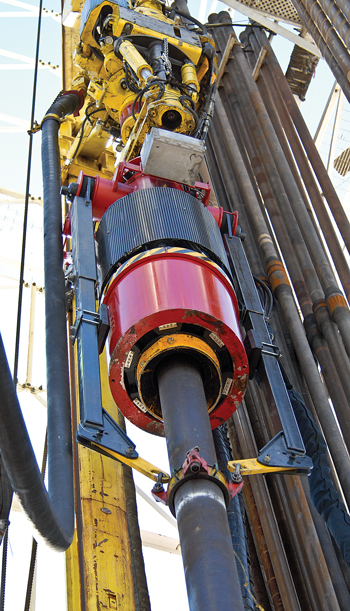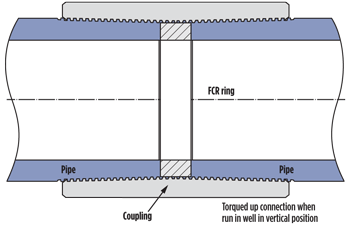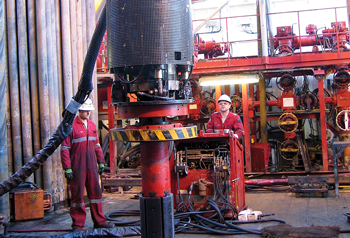BUDI UTAMA, Weatherford; and RICHARD READING, Apache Energy Ltd. Australia
In western Australia’s Carnarvon basin, drilling the 16-in. hole section and running 13⅜-in. casing was a long process. Fluid losses—sometimes total—required use of seawater to drill, and tight hole conditions resulted in back reaming, wiper trips and spotting pills. To reduce time spent fighting these problems and ensure the 13⅜-in. casing reached TD, a casing drill bit was employed to ream the casing to bottom while improving drill-out time. The operations were carried out using a top drive casing running system already installed on the rig.
The drilling-with-casing (DwC) operations effectively mitigated hole problems, yielded a safer and more cost-effective surface hole, and significantly reduced non-productive time (NPT). In reaching a total depth of 3,296 ft, the application also set a global service company and operator record for the longest section drilled with 13⅜-in. casing.
CASING BIT SELECTION
The Barberry-1 exploratory well is in the TL/2 permit area, southwest of Barrow Island off the northwest coast of Australia. One of the first tasks in preparing to drill with casing was a drillability analysis using data from two offset wells, Chervil-1 and Basil-1 ll. The analysis ensured that unique design limitations of casing drilling bits were considered when comparing performance to conventional drill bits. Based on regional experience, offset findings and previous product performance, a premium 13⅜ x 17½-in. DPC519 Defyer casing drilling bit was selected to ensure TD would be achieved at high ROP, Fig. 1. The bit is designed for drilling in medium-to-medium-hard formations with unconfined compressive strengths up to 15,000 psi. It features five displaceable steel blades with 19-mm PDC cutters. The blades are coated with a layer of tungsten carbide to provide resistance to erosion and abrasion during drilling. A pressure-cycled, PDC-drillable piston displaces the PDC-laden blades into the annulus after reaching TD.
 |
| Fig. 1. The 13⅜-in. x 17½-in. OD casing bit used offshore Australia is designed for unconfined compressive strengths up to 15,000 psi (1,034 bar). The bit’s five steel blades, fitted with 19-mm PDC cutters, are displaced at TD prior to cementing. |
|
Drillable nozzles with ceramic bore liners were fitted on the bit to resist fluid erosion at expected high flow rates. The 10 14/32-in. nozzles were matched to desired flow rate. Total flow area and hydraulic horsepower at the bit were calculated using proprietary hydraulic analysis software to enhance penetration rate.
DRILLING EQUIPMENT
A specialized top drive unit provided rotational force for turning the casing string. The Weatherford OverDrive top drive casing running and drilling system was already aboard the jackup drilling rig, Ocean Shield, where it had been used over the previous 18 months to rotate drill pipe. In prior work, the versatile drive was employed to drill-in 18⅝-in and 13⅜-in. casing strings.
The top drive, fitted with a 13⅜-in. internal clamping tool (ICT), extension bails, and single-joint elevators, was the primary means for making up and drilling with the casing string. It has a maximum rotary speed of 100 rpm and maximum pump pressure capacity of 3,750 psi. Flush mounted slips and hand slips were used to suspend and retain the casing in the rotary table as connections were being made up. Hand slips were employed to minimize damage to the flush mounted slips due to increased vibration experienced at greater hole depth, Fig. 2.
 |
| Fig. 2. The Weatherford top drive casing running and drilling system was already on the rig for standard drilling operations when the decision was made to implement DwC operations. |
|
A 13⅜-in. modified drilling-with-casing spear was prepared as a back up in the unlikely event of a top drive failure. Commonly used to drill-in casing strings, this simple tool has the capacity to drill the 13⅜-in. string to 1,000 m. The spear is connected to the top drive with a drill pipe pup joint and crossover sub. It incorporates a pack-off seal to retain pressure, gripping members, and a stop ring. The spear is inserted into the casing from the top. When the stop ring contacts the top of the connection or casing collar, slips are precisely positioned on the casing joint. A quarter turn to the right engages the grapple slips. As the top drive is elevated, the slips fully engage the inside casing diameter to hold the string and enable torque transmission. Removing tensile force from the spear and rotating a quarter-turn to the left releases the tool.
The float valve was modified for the application. A conventional poppet-type float valve cannot be used with the casing-drilling bit, because a ball (2.75 to 3-in. phenolic or aluminum) is required to cycle the tool and displace the cutting structure. Instead, the system uses a converted auto-fill float collar rated at 30 bbl/min for 24 hours using 12 to 12.5-ppg mud with 2 to 4% sand content. The auto-fill feature is not required for the DwC application, so its ball and tube assembly is removed in the workshop prior to make-up.
CASING AND CONNECTIONS
Casing drilling operations subject the casing string to many stresses, including cyclic fatigue, torsion cycles, and compression loads. The potential for this moderate wear must be considered in the casing design phase. Casing design must also factor in burst and collapse loads as well as sealing requirements after being subjected to these drilling stresses.
Casing and connection specifications for Barberry-1 called for 13⅜-in., 68 lb/ft, L-80 pipe with API buttress connections. This common casing connection does not have a torque shoulder inside the connector ("J" area), which results in low-torque transmission capacity. To provide additional torque resistance, dedicated torque rings were installed in each connection, Fig. 3. The torque ring is a pressure-actuated, metal-to-metal sealing system. When made up, initial contact force is established between the pin end and the fulcrum center torque ring. Additional internal pressure increases sealing contact force beyond axial loads and pressure of accepted string design limits.
 |
| Fig. 3. Torque rings were used to increase torque transmission capacity of the standard casing during drilling operations. |
|
To make up the casing, a special insertion tool was used to install and seat the ring in the "J" area prior to coupling. Make-up at 5 to 14 rpm requires close attention to torque. When torque begins to rise quickly, the pin nose has shouldered up to the rings.
DRILLING OPERATIONS
The 20-in. shoe was drilled out with a re-run 17½-in. roller cone bit, which then drilled on to a depth of 685.73 ft measured depth from the rotary table (MDRT) or 367.47 ft drilled. Two of the 36-in. hole opener cones were lost in the previous hole section; one was retrieved but the second cone remained in the hole. It was not encountered while drilling the 17½-in. hole to 685.73 ft MDRT.
Total losses were encountered while drilling the section, which is common for the area. At that point, the 17½-in. bottom-hole assembly (BHA) was pulled out of hole and the top drive system was rigged up to drill-in with 13⅜-in. casing. A job safety analysis was conducted to communicate the DwC running procedure and all associated potential hazards.
The pre-assembled shoe joint and casing-drilling bit was picked up and visually inspected to ensure all PDC cutters and blades were undamaged. The assembly was then run through the rotary table and flow tested to confirm that all nozzles were free of debris. The flush mounted slips were installed. The float collar joint was made up on the shoe joint and the connection was thread-locked. Torque rings were installed on the subsequent casing joints, which were made up to 25,000 ft-lb.
The string was washed down to TD at 250 gpm until bottom was tagged. Casing drilling operations began at 685.73 ft within recommended parameters of 60 to 100 rpm, 1,200 to 1,400 gpm and 1,000 to 25,000 lb WOB. High-viscosity sweeps were pumped every joint to deliver effective hole cleaning.
Some drilling-induced vibration was noted at surface. To avoid damage to the flush-mounted slips, they were replaced with conventional casing hand slips. Drilling continued to the section TD. Maximum drilling parameters were 80 to 100 rpm, 1,400 gpm at 1,350 psi standpipe pressure (SPP), 15,000 to 28,000 lb WOB and 15,000 to 22,000 ft-lb drilling torque.
Some minor problems were encountered drilling the section. The casing string stalled at 1,426 ft and a 25-bbl high viscosity sweep was pumped to resume the drilling process. When ROP dropped to around 98.43 to 164.05 ft/hr and SPP increased to 1,800 psi at 2,562 ft, the casing string was raised off bottom and partially hydrolyzed polyacrylamide (PHPA) mud was circulated around the bit to clear what appeared to be sticky claystone.
Drilling resumed with the torque limit increased to 16,000 ft-lb. High-viscosity, 25-to-30-bbl sweeps were pumped at every joint, with mud returns to surface observed during the entire casing drilling process. This is not typically observed when conventionally drilling this interval. Standpipe pressure dropped 250 psi from 1,350 to 1,100 psi at 3,215 ft. Reverse hydraulic calculations suggested that one or more nozzles might have lost their ceramic liners, thus slightly enlarging total flow area. However, the section was drilled without effect to TD at 3,296.09 ft MDRT.
At TD, a 150-bbl high-viscosity sweep was pumped to clean the hole prior to running the wellhead assembly. The wellhead assembly was made up and run in hole on a landing string using the top drive. A 3-in. phenolic ball was dropped and circulated downhole to displace the bit blades. The ball was chased at 400 gpm. An excellent indication of displacement was presented when the ball landed and the SPP built up to 1,600 psi before dropping to about 90 to 100 psi at 100 gpm. Cementing commenced once it was confirmed that the bit was fully displaced. The top drive system was retracted, the cement head rigged up, and cement was pumped according to plan.
SUCCESSFUL RESULTS
The 13⅜-in. DwC operation on the Barberry-1 well was successful by many measures. The planned depth of 3,296.09 ft MDRT was reached at a high ROP, which saved approximately 24 hours of rig operating time compared with offset wells drilled conventionally to a similar depth. Additional non-productive time was avoided by the onshore make-up of the 13⅜-in. casing-drilling bit to the float collar and casing.
Rigging up the top drive running and drilling system was accomplished without delay and according to plan. The system proved to be well-suited to drilling with the 13⅜-in. casing string. The torque rings installed in the “J” area of the coupling to provide extra torque resistance sustained the expected medium- to-medium-high drilling torque.
The 13⅜-in. x 17½-in. premium casing bit drilled from 685.73 ft to 3,296 ft for 2,610.36 ft of drilled depth. The average on-bottom ROP was 285.12 ft/hr. As a result, the section was drilled to TD in 16.27 hr, including connection time. Drilling the 3,296-ft section set a world record length for drilling with 13⅜-in. casing for both Apache and Weatherford.
The high-viscosity sweeps pumped with every joint ensured sufficient hole cleaning with the high ROP and increased cuttings volume. Circulation losses were mitigated by the “smear effect” mechanism produced by casing drilling, and mud returns were observed over the entire interval.
LESSONS LEARNED
Surveys taken afterward when tripping into hole with a 12¼-in. rotary steerable assembly recorded inclinations in the 13⅜-in. casing, growing from 1° at 685.73 ft to 3° at 1,640.5 ft and to 9.15° inclination at 3,185.85 ft. This equates to an average build rate of about 0.32° per 98.43 ft (30 m). Three main factors have contributed to building angle on Barberry-1. First is the high flow rate and potential for some formation intervals to wash out. While the critical annular velocity was 221 ft/min at 1,400 gpm, annular velocity between the casing and a gauge borehole (17½-in.) was 269 ft/min.
High WOB could have effectively tilted the bit to deflect the wellbore from vertical. This effect is multiplied where borehole wall erosion is present. Building angle could also be due to the relationship of the outer diameter of the casing bit to outer diameter of the casing, combined with high flow rate and bit weight.
Changes in the relationship between casing bit and casing OD were not achievable on the Barberry-1, because internal and external dimensional limitations of the 13⅜-in. casing bit prevent a design with a final borehole diameter any smaller than 17½ in. Advances in casing bit technology now allow a smaller final outer diameter of 16 in. Along with decreased flow rates and WOB, the new design should reduce the build tendency.
CASING DRILLING SOLUTION
Success in drilling the troublesome top-hole section of the Barberry-1 demonstrated the effectiveness of casing drilling methods relative to conventional drill pipe operations. The capabilities of casing drilling enabled by a unique top drive running and drilling system resulted in a significant reduction in rig time due to problem mitigation and operational efficiency. 
THE AUTHOR
|
 |
BUDI UTAMA graduated with a BS in Petroleum Engineering from Universitas Pembangunan Nasional in Indonesia. He joined Weatherford Indonesia in 2006 as a managed pressure field engineer. He transferred to the Drilling with Casing department as an applications engineer and presently works in onshore planning and assists in drilling with casing field applications.
|
| |
|
 |
RICHARD READING began working in the oilfield in 1992 with ODE on Barrow Island for two years, for WAPET in Western Australia. In 2007, he went to work for Apache Energy as a drilling supervisor on the Van Gogh project. After several months in this position, he moved to the Perth office as a workover coordinator while pursung a degree from the University of Western Australia in oil and gas engineering. Upon completing his degree, he accepted his present position as a drilling engineer with Apache in the Perth office.
|
|








